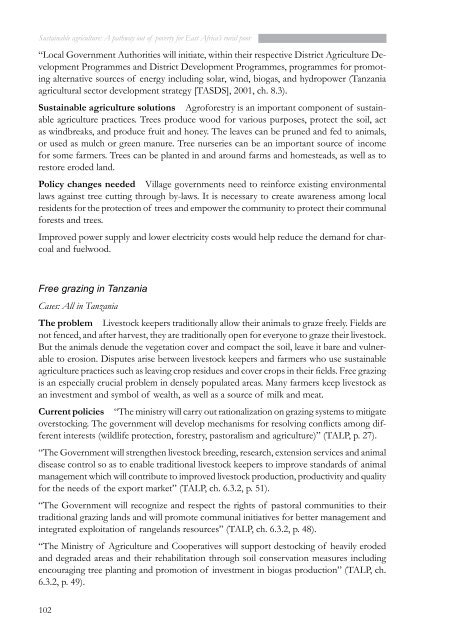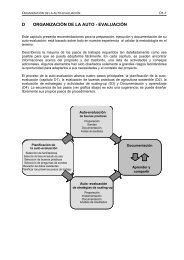cases from tanzania - Sustainet
cases from tanzania - Sustainet
cases from tanzania - Sustainet
You also want an ePaper? Increase the reach of your titles
YUMPU automatically turns print PDFs into web optimized ePapers that Google loves.
Sustainable agriculture: A pathway out of poverty for East Africa’s rural poor<br />
“Local Government Authorities will initiate, within their respective District Agriculture Development<br />
Programmes and District Development Programmes, programmes for promoting<br />
alternative sources of energy including solar, wind, biogas, and hydropower (Tanzania<br />
agricultural sector development strategy [TASDS], 2001, ch. 8.3).<br />
Sustainable agriculture solutions Agroforestry is an important component of sustainable<br />
agriculture practices. Trees produce wood for various purposes, protect the soil, act<br />
as windbreaks, and produce fruit and honey. The leaves can be pruned and fed to animals,<br />
or used as mulch or green manure. Tree nurseries can be an important source of income<br />
for some farmers. Trees can be planted in and around farms and homesteads, as well as to<br />
restore eroded land.<br />
Policy changes needed Village governments need to reinforce existing environmental<br />
laws against tree cutting through by-laws. It is necessary to create awareness among local<br />
residents for the protection of trees and empower the community to protect their communal<br />
forests and trees.<br />
Improved power supply and lower electricity costs would help reduce the demand for charcoal<br />
and fuelwood.<br />
Free grazing in Tanzania<br />
Cases: All in Tanzania<br />
The problem Livestock keepers traditionally allow their animals to graze freely. Fields are<br />
not fenced, and after harvest, they are traditionally open for everyone to graze their livestock.<br />
But the animals denude the vegetation cover and compact the soil, leave it bare and vulnerable<br />
to erosion. Disputes arise between livestock keepers and farmers who use sustainable<br />
agriculture practices such as leaving crop residues and cover crops in their fields. Free grazing<br />
is an especially crucial problem in densely populated areas. Many farmers keep livestock as<br />
an investment and symbol of wealth, as well as a source of milk and meat.<br />
Current policies “The ministry will carry out rationalization on grazing systems to mitigate<br />
overstocking. The government will develop mechanisms for resolving conflicts among different<br />
interests (wildlife protection, forestry, pastoralism and agriculture)” (TALP, p. 27).<br />
“The Government will strengthen livestock breeding, research, extension services and animal<br />
disease control so as to enable traditional livestock keepers to improve standards of animal<br />
management which will contribute to improved livestock production, productivity and quality<br />
for the needs of the export market” (TALP, ch. 6.3.2, p. 51).<br />
“The Government will recognize and respect the rights of pastoral communities to their<br />
traditional grazing lands and will promote communal initiatives for better management and<br />
integrated exploitation of rangelands resources” (TALP, ch. 6.3.2, p. 48).<br />
“The Ministry of Agriculture and Cooperatives will support destocking of heavily eroded<br />
and degraded areas and their rehabilitation through soil conservation measures including<br />
encouraging tree planting and promotion of investment in biogas production” (TALP, ch.<br />
6.3.2, p. 49).<br />
102




